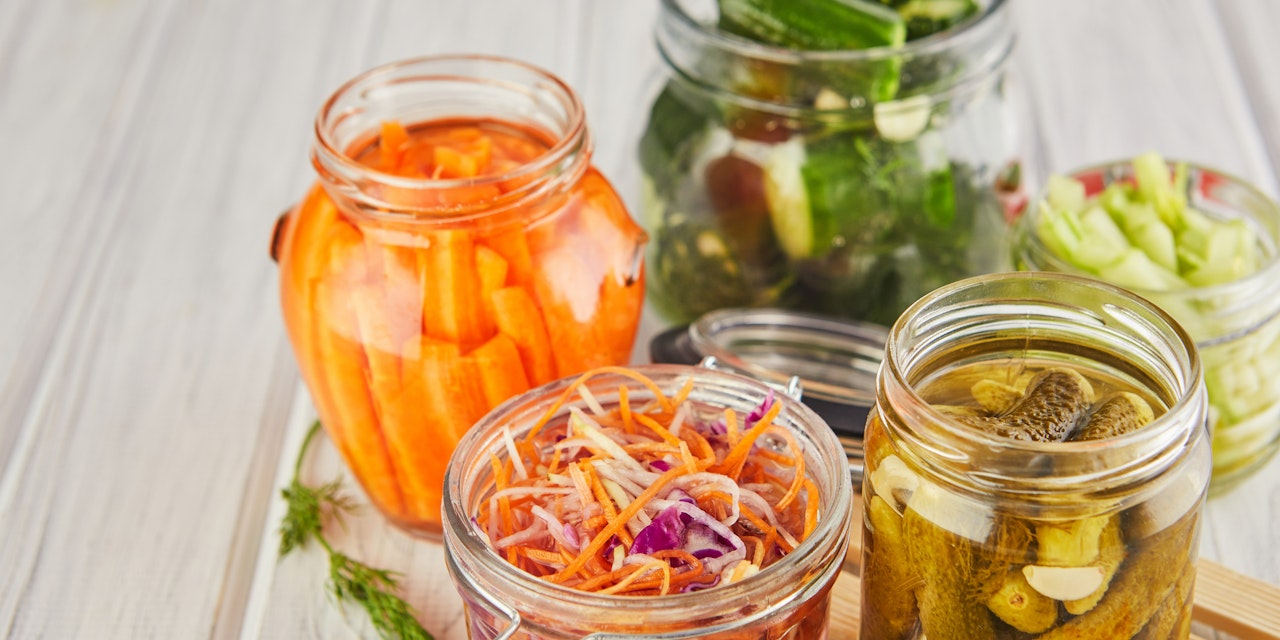Fermented Foods & Fibers – Practical Tips for Gut Health
The gut is often called the “second brain”. In many ways, it’s also a thriving garden, in which fiber is the soil and fermented foods are the seeds.
- Published: 11/3/2025
- Categories:
- 2 min. read

- Published: 11/3/2025
- Categories:
- 2 min. read
Why Fiber Matters
Fiber isn’t only about keeping digestion regular. It’s the primary food source for gut microbes. When bacteria ferment dietary fiber, they produce short-chain fatty acids (SCFAs) such as butyrate, acetate, and propionate. These compounds reduce inflammation, strengthen the gut lining, and support overall metabolic health (3, 4).
There are two main types of fiber, each playing a distinct role:
- Soluble fiber: Found in oats, legumes, apples, and carrots. It dissolves in water, forming a gel-like substance that slows digestion and nourishes beneficial bacteria.
- Insoluble fiber: Found in whole grains, nuts, seeds, and many vegetables. It adds bulk to stool, supporting regularity and preventing constipation.
A diverse intake of both ensures that different groups of microbes are fed, promoting a more resilient gut ecosystem (5).
The Power of Fermented Foods
Fermented foods deliver probiotics — live microorganisms that help balance and replenish gut bacteria. Beyond probiotics, fermentation also produces bioactive compounds that can enhance digestion and nutrient absorption (6).
Common examples include:
- Dairy-based: Yogurt, kefir, certain aged cheeses
- Vegetable-based: Sauerkraut, kimchi, naturally fermented pickles (not vinegar-based)
- Soy-based: Miso, tempeh, natto
- Beverages: Kombucha, kvass, and other traditional ferments
By including these foods regularly, you introduce a variety of beneficial bacteria into the digestive tract. Research suggests this can improve immunity, enhance digestion, and even support mental well-being via the gut–brain axis (7, 8).
Practical Tips for Everyday Gut Support
Small, consistent choices are what matter most for gut health:
- Build your plate around plants: Aim for at least 30 different plant foods per week — including vegetables, fruits, legumes, nuts, seeds, and whole grains. Variety is key to fueling microbial diversity (9).
- Pair fiber with fermentation: Create a synbiotic effect by combining fermented foods with fiber. For example, top a whole grain salad with sauerkraut, or enjoy kefir with fruit and oats. Probiotics and prebiotics work best together.
Nurturing Your Inner Ecosystem
Fermented foods and fibers are not just trendy wellness fads — they are time-tested pillars of traditional diets around the world. By weaving them into daily meals, you’re not only nourishing yourself, but also cultivating the trillions of microbes that support digestion, immunity, and long-term health.
A thriving microbiome is built meal by meal, bite by bite. With every serving of fiber and every spoonful of fermented food, you’re nurturing one of your body’s most powerful allies.
9 references (hide)
All of the content and media on Lifesum is created and published for information purposes only. It is not intended to be used as a substitute for medical advice or treatment. Users should always consult with a doctor or other health care professional for medical advice. If you have or think you are at risk of developing an eating disorder, do not use the Lifesum app and seek immediate medical help.